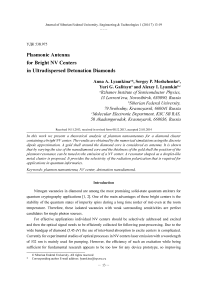Plasmonic antenna for bright NV centers in ultradispersed detonation diamonds
Автор: Lyamkina Anna A., Moshchenko Sergey P., Galitsyn Yuri G., Lyamkin Alexey I.
Журнал: Журнал Сибирского федерального университета. Серия: Техника и технологии @technologies-sfu
Статья в выпуске: 1 т.7, 2014 года.
Бесплатный доступ
In this work we present a theoretical analysis of plasmon nanoantennas for a diamond cluster containing a bright NV center. The results are obtained by the numerical simulations using the discrete dipole approximation. A gold shell around the diamond core is considered as antenna. It is shown that by varying the size of the nanodiamond core and the thickness of the gold shell the position of the plasmon resonance can be tuned to the emission of a NV center. A resonator shaped as a droplet-like metal cluster is proposed. It provides the selectivity of the radiation polarization that is required for applications in quantum informatics.
Plasmon nanoantenna, nv center, detonation nanodiamond, nv-центр
Короткий адрес: https://sciup.org/146114817
IDR: 146114817 | УДК: 538.975
Текст научной статьи Plasmonic antenna for bright NV centers in ultradispersed detonation diamonds
Nitrogen vacancies in diamond are among the most promising solid-state quantum emitters for quantum cryptography applications [1, 2]. One of the main advantages of these bright centers is the stability of the quantum states of impurity spins during a long time (order of ms) even at the room temperature. Therefore, these isolated vacancies with weak surrounding sensitivities are perfect candidates for single photon sources.
For effective applications individual NV centers should be selectively addressed and excited and then the optical signal needs to be efficiently collected for following post-processing. Due to the wide bandgap of diamond (5.45 eV) the use of inter-band absorption to excite centers is complicated. Currently for experimental studies of optical processes in NV centers laser emission with a wavelength of 532 nm is mainly used for pumping. However, the efficiency of such an excitation while being sufficient for fundamental research appears to be too low for any device prototype, so improving
In this work a theoretical analysis of plasmon nanoantennas for a diamond cluster containing an NV center is presented. Nanoantennas have the form of a gold shell around the diamond core. It is shown that by varying the size of the nanodiamond core and the thickness of the gold shell the position of the plasmon resonance can be adjusted to the emission of a NV center. When a contact in the form of a disk is included to the consideration the symmetry degeneracy is removed. That leads to the arising of an additional resonant wavelength which can be used to pump the vacancy. Also, a resonator shaped as a droplet-like metal cluster is proposed providing the selectivity of the radiation polarization that is required for applications in the quantum information.
Methods
In this work numerical simulations using the discrete dipole approximation (DDA) were used to study the plasmonic antennas [5]. In DDA a target is replaced by an array of point dipoles and then the electromagnetic scattering problem for an incident periodic wave interacting with this array can be solved quite precisely. Thus any shape can be modeled provided the interdipole distance is small enough to perform shape features. The polarizabilities of the dipoles are determined by the material dielectric constants. The output of the DDA simulations used in this work is the efficiency of the nanostructure absorption Q abs defined as the absorption cross section normalized to the geometrical cross section: Q abs = C abs [n ■ a 2 f , where C abs denotes the absorption cross section and aeff is the effective
3 eff .
radius, i.e. the radius of a sphere with an equivalent volume: V = 3 n a
Results and discussion
The easiest way to create a hybrid plasmon resonator is the deposition of a metal (e.g. gold) directly onto the surface of the nanodiamond to form a core-shell type structure. It is well known that in such a structure the position of the plasmon resonance depends strongly both on the materials and in the ratio of the dielectric core size and the metal shell thickness [6]. We performed simulations for spherical diamond particles having sizes that are typical for a detonation synthesis method [7] with a gold shell of varying thickness. Fig. 1 shows the absorption spectra of the diamond spheres with the diameter in a range of d = 4 ÷ 10 nm coated with a gold layer thickness of 2 nm. It is seen that with the increase in the core size the plasmon resonance is shifted to longer wavelengths due to the corresponding increase of the gold shell size. The resonance wavelength for d = 10 nm is 620 nm – 14 –
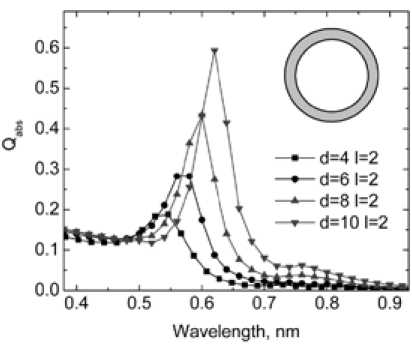
Fig.1. Absorption spectra for spherical diamond particles with the diameter d = 4-10 nm covered by a gold shell with the thickness l = 2 nm
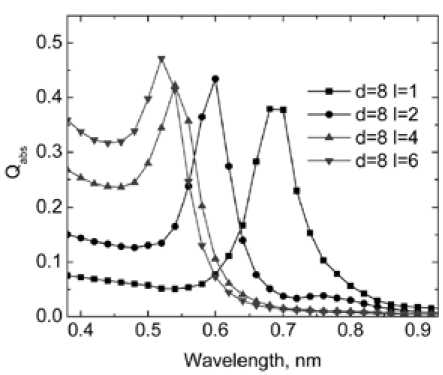
Fig. 2. Absorption spectra for spherical diamond particles with the diameter d = 8 nm covered by a gold shell with the thickness of l = 1-6 nm which is close to the zero-phonon line of the nitrogen vacancy (637 nm). Fig. 2 presents absorption spectra for particles with the constant diameter d = 8 nm and a gold shell thickness of 1 – 6 nm. Here the inverse relationship is observed, the thicker the gold film the larger the spectral shift to shorter wavelengths. Apparently, this is due to the interaction of the plasmon modes on the inner and outer surfaces of the metal sphere.
Therefore, by varying available geometrical parameters such as the size of the nanodiamond core and the thickness of the gold shell one can tune the plasmon resonance to the NV center emission.
To study the system including both the radiative center with the antenna and a plasmonic waveguide we examined a model consisting of a diamond particle with a shell placed on top of a metal disk. The model is schematically shown in the inset in Fig. 3. In this configuration the symmetry of the object is reduced, that leads to the removal of the polarization degeneracy when the light incidence is angular – 15 –
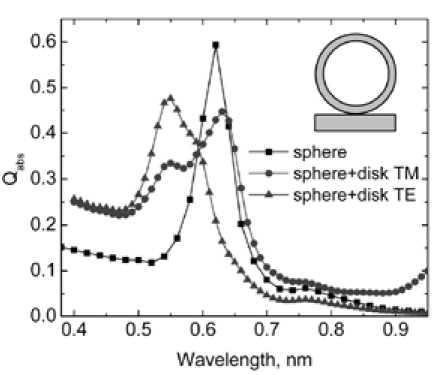
Fig. 3. Absorption spectra for spherical diamond particles with the diameter d = 10 nm covered by the gold shell with the thickness of l = 2 nm placed on the gold disk with a diameter of 14 nm and the height of 4 nm for different polarizations of the incident light. The spectrum for a particle without disk is shown for comparison towards the symmetry axis. In our numerical simulations this angle was set to be 45º. The simulation results for the diamond core with d = 10 nm coated by 2 nm of gold and placed on a gold disk having a diameter of 14 nm and a height of 4 nm are shown in Fig. 3.
The removal of degeneracy leads to the splitting of plasmon modes and, together with the already presented resonance peak at 620 nm a new short-wave peak appears at 550 nm. Thus it is possible to achieve the presence of several plasmon modes and to drive resonances by controlling the system geometry. When a long-wavelength plasmon mode is tuned to the resonance with the radiative center, the pumping and the signal collection can be carried out via different channels using the same resonator. Furthermore, as demonstrated in Fig. 3 different polarizations of the incident light can correspond to different resonant wavelengths. This sensitivity to the emitted photon polarization can be used to implement the qubit states 0 and 1 which are the orthogonal polarizations of emitted photons respectively detected by the same plasmon antenna. However, for the described system the absorption ratio for TE and TM polarizations is small, so the plasmon resonator geometry needs to be optimized to exploit this effect.
Another viable option of a metal resonator is a droplet of metal located on the substrate near the nanodiamond. The arrays of such droplets can be formed with the deposition of group III metals during MBE growth [8]. First, the diamond particles can be placed near the droplets first with an atomic force microscope to detect the effect of individual pairs. Then the deposition of diamonds can be carried out e.g. by the laser evaporation of a suspension [9]. Such structures with a density of complexes of 107-1010 cm-2 perform a new metamaterial, namely an active medium with high optical efficiency. In our previous research we examined the metal droplets produced by this method [8] and showed that they can be effectively used for the design of plasmonic modes [10]. A droplet, being a segment of the sphere is schematically shown with the incident light in the inset in Fig. 4, while Fig. 4 itself presents the absorption spectra for the indium droplet with a height of 40 nm and a base diameter of 350 nm for the TE polarization and different angles of – 16 –
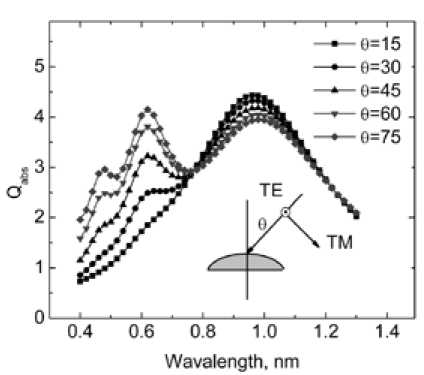
Fig. 4. Absorption spectra for an indium droplet with a height of 40 nm and a base diameter of 350 nm for TE polarization and different angles of incidence
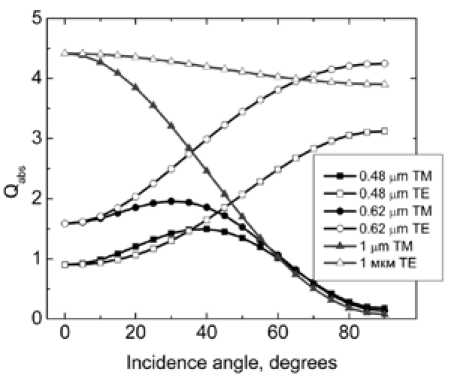
Fig. 5. Angle dependence of absorption for resonance wavelengths obtained in Fig. 4 for TE and TM polarizations incidence θ. The presence of diamond particles i.e. a dielectric sphere near a massive metal cluster has only a small effect on its plasmon resonances, so at this stage the presence of the particles was not taken into account.
Fig. 4 confirms that there is a set of resonant wavelengths and the resonance intensity depends significantly on the incidence angle of light. The wavelength of 620 nm is close to the emission of nitrogen vacancy as was mentioned above, and the peak at 480 nm can be used for pumping, for example, by an argon laser. Fig. 5 demonstrates the angular dependence of the absorption at the resonance wavelengths obtained from Fig. 4 for the TE and TM polarizations.
When the angle of incidence increases the absorption of TM wave decreases significantly, while the absorption of the TE wave increases. For instance, for the angle of 75º the ratio of absorption – 17 – amplitudes for TE and TM light is a factor of 4/0.4 = 16. Such a significant difference in the intensity provides a high selectivity of the droplet nanoantenna to the polarization.
Conclusion
In this study we investigated the plasmonic nanoantenna for diamond particles possessing a bright NV center. Resonators in a form of a gold shell around the diamond core and a metal droplet were considered. It was shown that by changing the size of the diamond core and the golden shell thickness the plasmon resonance can be tuned to the emission of a NV center. When a contact modeled as a gold disk was considered the polarization degeneracy was removed and an additional resonant wavelength appeared in the spectrum. The short-wavelength line can be used to pump the NV center while the emitted signal is enhanced and collected by the long-wavelength plasmon mode within the same antenna. A resonator shaped as a metal droplet was demonstrated to provide a high polarization selectivity that is required for applications in quantum information.
The work was supported by the RFBR (12-07-31133, 13-02-00959). AAL acknowledges the financial support via RF president scholarship (SP-805.2013.3).

